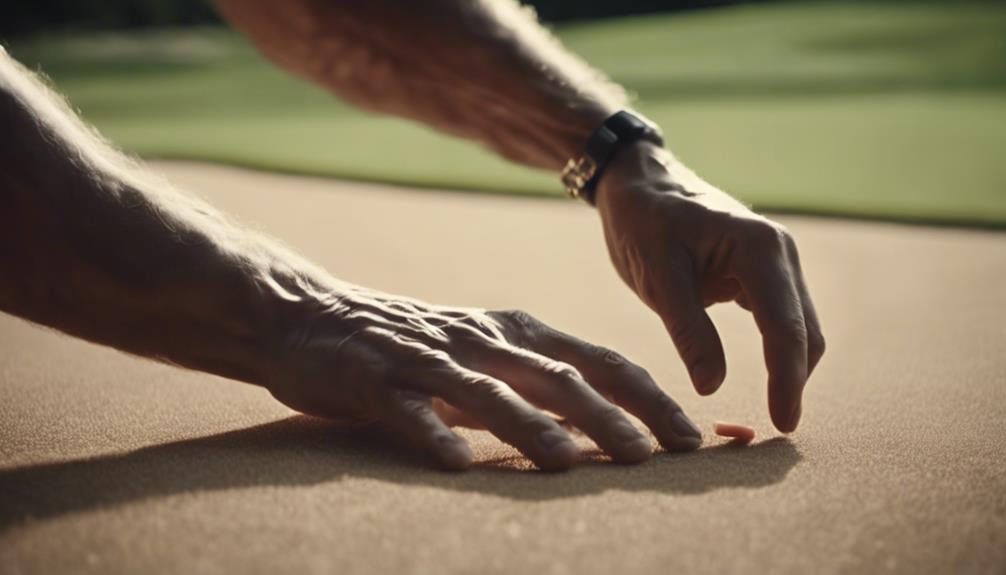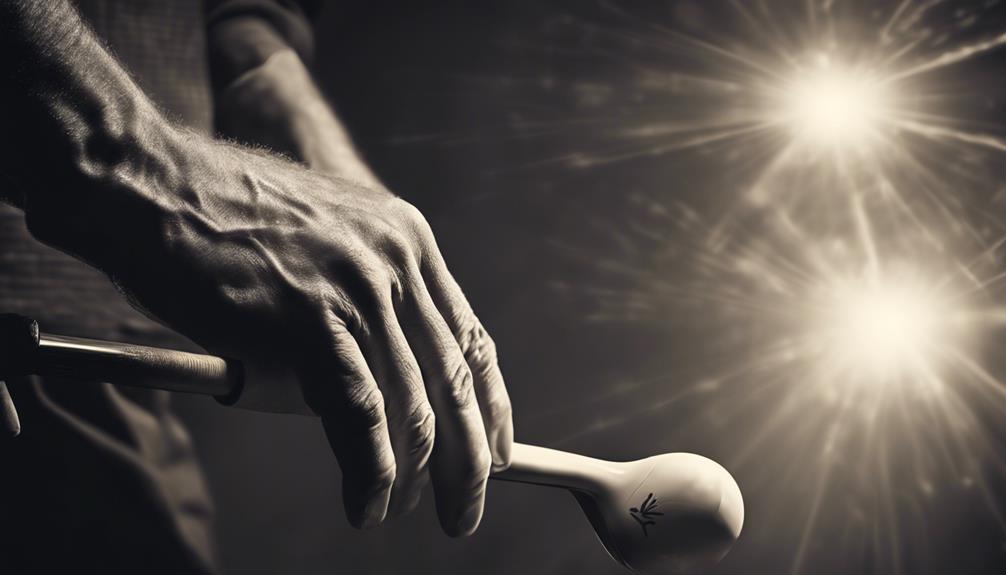- 7 Top Flite Golf Clubs XL for Improved Performance - September 28, 2024
- Top Flite Golf Clubs: Top 5 Reasons to Choose Them - September 28, 2024
- Top 3 Golf Club Fitters for a Perfect Swing - September 28, 2024
You master the golf club grip by establishing a solid foundation through proper finger and palm placement, recognizing the grip's critical connection between your body and the club. Experiment with overlap, interlock, or two-handed grip techniques to find what works best for you. Pay attention to lead hand techniques, like placing the club in your fingers and positioning the V towards your trail shoulder. Anchor your trail hand correctly for power and control. Aim for moderate grip pressure, around 4 or 5 out of 10, to enhance performance. By perfecting these elements, you'll access the secrets to a consistent and powerful swing.
Key Takeaways
- Establish a solid grip foundation by grasping the club correctly in fingers and palm, experimenting with overlap, interlock, or two-handed grip techniques.
- Place the club in the fingers of your lead hand, ensuring the heel pad sits on top for better control and the V points towards your trail shoulder for alignment.
- Anchor the trail hand correctly, placing fingers underneath the grip with the lifeline on top of the lead hand's thumb, and the V formed by thumb and forefinger pointing towards the trail shoulder.
- Aim for balanced grip strength around 4 or 5 out of 10, equilibrating grip strength between hands for proper club control and avoiding extreme tension.
- Commit to consistent practice and muscle memory development, reinforcing correct grip technique to unleash the full potential of your golf game.
Understanding Grip Fundamentals
When establishing a solid foundation for your golf swing, start by recognizing that the grip is the critical connection between your body and the club, directly influencing control and consistency throughout the swing.
As you grasp the club, remember that it's the only physical link between you and the club head, making it essential for a precise golf swing. To achieve proper grip alignment, position the club correctly in the fingers and palm of your lead hand, ensuring the V points towards your trail shoulder. Your trail hand then complements this positioning by providing support and control. You can experiment with overlap, interlock, or two-handed grip techniques to find what works best for you.
Don't forget to maintain moderate grip pressure, around 4 or 5 out of 10, to balance control with a fluid swing. By mastering these fundamental grip principles, you'll develop muscle memory, leading to improved ball striking, control, and overall performance on the course.
Mastering Lead Hand Techniques
To master the golf club grip, start by placing the club in the fingers of your lead hand, making sure the heel pad sits on top, which allows for better control and precise club face alignment. This fundamental technique is essential for hitting consistent shots.
To further refine your lead hand grip, focus on the following key elements:
- Make sure the V between your thumb and forefinger points towards your trail shoulder, promoting proper alignment.
- Position the anatomical snuff box on top of the club, optimizing grip strength and accuracy.
- Keep your lead hand knuckles visible, maintaining a correct grip for improved swing power.
Perfecting Trail Hand Grip

By anchoring your trail hand correctly, you'll generate additional power and control in your swing, while also supporting your lead hand's grip on the club.
To achieve this, place your trail hand fingers underneath the grip, ensuring your lifeline is positioned on top of your lead hand's thumb. This solid connection will provide the necessary support for your lead hand.
Next, focus on the angle of the V formed by your trail hand's thumb and forefinger, making sure it points towards your trail shoulder for proper alignment.
Lady golfers, in particular, can benefit from a strong trail hand grip, as it helps maintain club control throughout the swing.
You have the option to adopt an overlap, interlock, or two-handed grip for your trail hand, each offering unique benefits.
By perfecting your trail hand grip, you'll complement your lead hand's grip, resulting in improved club control and increased swing speed.
With practice and patience, you'll develop a consistent and powerful swing, allowing you to take your game to the next level.
Achieving Optimal Grip Pressure
Now that you've perfected your trail hand grip, focus on achieving ideal grip strength, as it's the key to harnessing the power and control you need to elevate your game. A good idea is to aim for a balanced grip strength of around 4 or 5 out of 10, allowing for control without excessive tightening.
Here are three key things to keep in mind:
- Equilibrate grip strength between hands: Make sure to distribute the strength evenly between your hands to maintain proper club control throughout the swing.
- Avoid extreme tension: Too firm of a grip can impede clubhead speed and lead to inaccurate shots.
- Don't grip too lightly: Gentle grip strength can result in loss of control and power during the swing.
Developing Long-Term Mastery

You'll solidify your grip mastery over time by committing to consistent practice and muscle memory development, which lays the groundwork for long-term improvement and a more reliable swing. As you dedicate yourself to regular grip practice, you'll notice improvements in your ball striking, control, and accuracy on the course. By establishing a strong foundation through consistent grip practice, you'll set the stage for skill development and improvement. Long-term benefits of mastering the grip include reduced swing faults and increased confidence in your game.
Regularly reinforcing correct grip technique helps build a solid foundation for better performance and enjoyment in golf. You'll find that your golf club grip becomes second nature, allowing you to focus on other aspects of your game. With a solid grip, you'll be able to tackle challenging shots with confidence, knowing that your foundation is strong. By committing to long-term mastery, you'll unleash the full potential of your golf game and enjoy the many rewards that come with it.
Frequently Asked Questions
How Can I Improve My Golf Grip?
You can improve your golf grip by focusing on proper hand positioning, ensuring the club sits in your fingers and palm, and experimenting with grip styles, such as overlap or interlock, while maintaining moderate grip pressure.
What Is the Correct Way to Grip a Golf Club?
You grip a golf club correctly by placing the club in your lead hand's fingers, with the heel pad on top, and forming a V between thumb and forefinger, while maintaining ideal hand placement and finger pressure.
How Does Rory Mcilroy Grip the Club?
As you grasp the club, Rory McIlroy's grip becomes your blueprint: strong left hand on top, V-pointing to your right shoulder, with your right hand lower for control, and interlocked fingers unifying your grip pressure and hand position for optimized swing mechanics.
How Should Seniors Grip a Golf Club?
You, as a senior golfer, will overcome gripping challenges by adopting techniques like the overlap grip, utilizing marking gloves, and maintaining best grip pressure to guarantee a comfortable, consistent, and controlled swing.
Conclusion
As you wrap your hands around the club, envision a vice-like grip that channels your swing's kinetic energy.
With lead hand techniques honed, trail hand grip perfected, and ideal pressure achieved, your game is transformed.
Like a conductor leading an orchestra, your grip harmonizes every swing, releasing a symphony of precision and power.
Now, commit to long-term mastery, and your grip will become second nature, a seamless extension of your golfing DNA.




